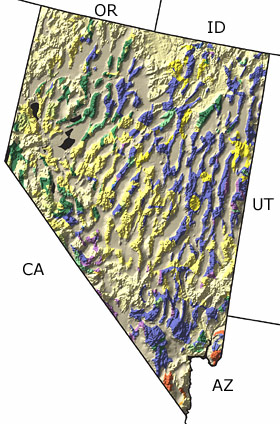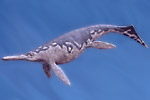Paleontology and geologyThe Precambrian: Few Early Precambrian rocks are preserved in Nevada. Fossils of blue-green bacteria in some Late Precambrian rocks in the southern and eastern part of the state indicate that shallow seas began to flood the edge of a quiet continental margin. The Paleozoic: In contrast, Paleozoic rocks are well represented in Nevada. Warm shallow seas gradually flooded the state during the early part of this time interval and continued to cover the southern and eastern part of the state through the Devonian, but the water deepened into an ocean basin to the northwest. Reef communities flourished in the shallower parts of the sea, while fossils of graptolites and other floating organisms are preserved in some of the deep-water deposits. An episode of mountain building (the Antler Orogeny) occurred toward the end of the Devonian and continued into the early part of the Carboniferous. By the Permian, sea level had dropped and parts of Nevada were dry land. Plant fossils can be found in rocks formed in shallow lagoons and beaches in the eastern part of the state, while scattered reefs still existed in the north and northeast. Deep oceans persisted in the northwest, and the chert and shale from this time are rich in the fossils of plankton. The Mesozoic: The Mesozoic was a time of changing sea level and intense tectonic activity. In the Triassic, the ocean continued to recede; however, deeper water persisted in the central and western parts of the state, and fossils of ichthyosaurs and ammonites are abundant. Rocks from the Jurassic indicate a deep-water environment limited to the northwest, a shallow marine environment in the central area, and non-marine environments to the south and east. Cretaceous rocks are rare in Nevada, but they indicate that a volcanic island arc formed along the western edge of the state. Scattered twigs believed to be from Sequoia trees are reported from Eureka County are the only known Cretaceous fossils from the state. The Cenozoic: During the Early Cenozoic (Tertiary), tectonic activity was intense and blocks of crust rose to form mountains, while others dropped to form basins, initiating the Basin and Range Province we see today. Mammoths, rhinos, and horses roamed through woodlands populated with oak, redwood, and willow. Volcanic eruptions were frequent. During the Late Cenozoic (Quaternary), the Sierra Nevada Mountains were uplifted, and glaciers sculpted the highest peaks. Mammoths, horses, camels, and giant ground sloths roamed freely. Volcanic eruptions continued throughout the state, depositing ash flows and lava. |
|
Organizations | Education and Exhibits | Resources
Organizations
Parks (showing 1 of 1 listings)
Berlin-Ichthyosaur State Park: This park was first established in 1957 to protect and display North America's most abundant concentration of, and largest known, ichthyosaur fossils.
 Top of List Top of List
Colleges and Universities (showing 1 of 1 listings)
A Guide to the Geoscience Department at the University of Nevada, Las Vegas: This site provides a guide to the admissions and degree requirements for the graduate program within the Department of Geosciences at the University of Nevada, Las Vegas. Research facilities and specialties are also listed.
 Top of List Top of List
Museums (showing 2 of 2 listings)
Mineral County Museum: Located in Hawthorne, this museum's collections feature some fossil displays.
Nevada State Museum - Las Vegas: This site describes the museum's programs and exhibits, including specimens of Shonisaurus popularis and the Columbian Mammoth on display in the Earth Sciences Gallery.
 Top of List Top of List
Government Agencies (showing 1 of 1 listings)
Nevada Bureau of Mines and Geology: Information about this state organization
 Top of List Top of List
Education and Exhibits
Virtual Exhibits (showing 1 of 1 listings)
A Visit To Ammonite Canyon, Nevada: A virtual field trip to a world-famous late Triassic-early Jurassic fossil locality; detailed text; on-site images; images of fossils.
 Top of List Top of List
Physical Exhibits (showing 1 of 1 listings)
The Pleistocene Nevada Exhibit: The Nevada State Museum in Carson City maintains an exhibit on the Pleistocene in Nevada including a look at the paleoecology of that time.
 Top of List Top of List
Events and Programs (showing 1 of 1 listings)
Late Triassic Ichthyosaur And Invertebrate Fossils In Nevada: Virtual field trips to two classic fossil localities in the Upper Triassic Luning Formation of Nevada; detailed text; on-site images; photos of fossils.
 Top of List Top of List
Resources
Courses and Lectures (showing 1 of 1 listings)
Paleogeography of the Southwestern U.S.: The paleogeography of the southwestern U.S. from 1.8 billion years ago to 10 million years ago. Text and images by Dr. Ron Blakey from Northern Arizona University.
 Top of List Top of List
Field Guides (showing 3 of 9 listings)
Fossil Plants At Aldrich Hill, Nevada: A virtual field trip to a famous fossil plant locality in, Nevada; detailed text; on-site images; many images of fossils.
Ordovician Fossils At Great Beatty Mudmound, Nevada: A virtual field trip to a classic 480-million-year-old fossil locality in the vicinity of Beatty, Nevada, near Death Valley National Park; detailed text; images of fossils; on-site images.
Early Cambrian Fossils In Western Nevada: Take a virtual field trip to a prolific fossil locality north of Death Valley National Park; detailed text; images of fossils; on-site images.
 More Field Guides More Field Guides
 Top of List Top of List
Image Collections (showing 3 of 3 listings)
Fossils From The Savage Canyon Formation, Nevada: Images of fossil leaves and insect from the famous middle Miocene Savage Canyon Formation, Nevada.
Fossil Giant Sequoia Foliage From Nevada: Image of the youngest fossil foliage of giant sequoia yet discovered, with explanatory text.
Some Fossil Brachiopods: Images of several fossil brachiopods, dating in geologic age from early Cambrian to Pleistocene, with explanatory text.
 Top of List Top of List
General Reference (showing 1 of 1 listings)
Middle Triassic Ammonoids From Nevada: A virtual visit to a world-famous fossil ammonoid locality in Nevada roughly 235 million years old--it could well be the single best middle Triassic ammonoid locality in the world; many images of fossils; on-site images.
 Top of List Top of List
|



